The GIGABYTE X470 Gaming 7 Wi-Fi Motherboard Review: The AM4 Aorus Flagship
by Gavin Bonshor on July 26, 2018 8:00 AM EST- Posted in
- Motherboards
- AMD
- Gigabyte
- AORUS
- Ryzen
- X470
- Ryzen 2
- Gaming 7 Wi-Fi
- Gaming 7
System Performance
Not all motherboards are created equal. On the face of it, they should all perform the same and differ only in the functionality they provide - however, this is not the case. The obvious pointers are power consumption, but also the ability for the manufacturer to optimize USB speed, audio quality (based on audio codec), POST time and latency. This can come down to manufacturing process and prowess, so these are tested.
Power Consumption
Power consumption was tested on the system while in a single ASUS GTX 980 GPU configuration with a wall meter connected to the Thermaltake 1200W power supply. This power supply has ~75% efficiency > 50W, and 90%+ efficiency at 250W, suitable for both idle and multi-GPU loading. This method of power reading allows us to compare the power management of the UEFI and the board to supply components with power under load, and includes typical PSU losses due to efficiency. These are the real world values that consumers may expect from a typical system (minus the monitor) using this motherboard.
While this method for power measurement may not be ideal, and you feel these numbers are not representative due to the high wattage power supply being used (we use the same PSU to remain consistent over a series of reviews, and the fact that some boards on our test bed get tested with three or four high powered GPUs), the important point to take away is the relationship between the numbers. These boards are all under the same conditions, and thus the differences between them should be easy to spot.
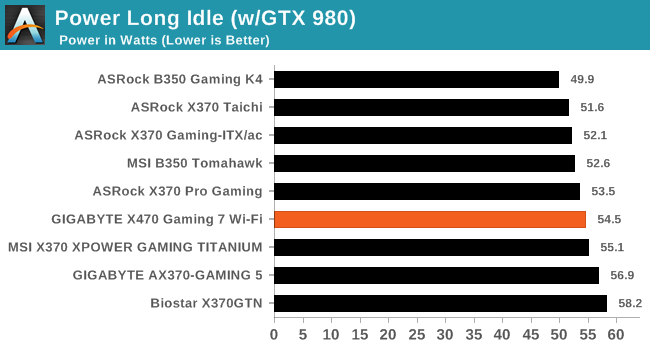
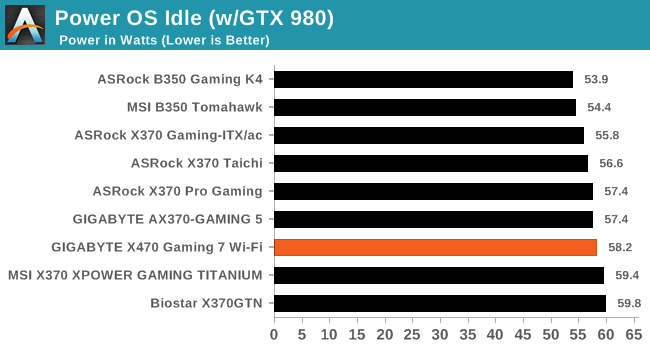
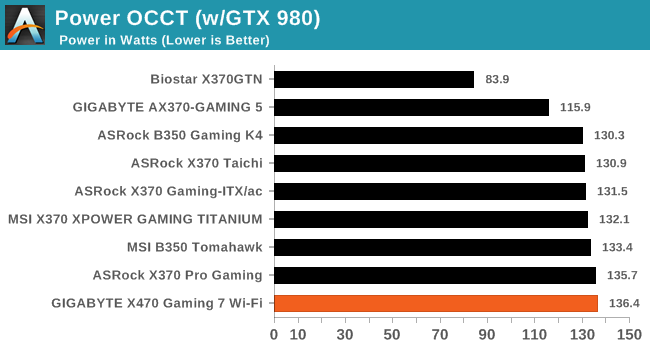
While one of the main benefits of X470 over the previous X370 chipset is a slight reduction in TDP under load, that hasn't been noticeable here as the Gaming 7 Wi-Fi is notable power hungrier than any other AM4 board.
Non-UEFI POST Time
Different motherboards have different POST sequences before an operating system is initialized. A lot of this is dependent on the board itself, and POST boot time is determined by the controllers on board (and the sequence of how those extras are organized). As part of our testing, we look at the POST Boot Time using a stopwatch. This is the time from pressing the ON button on the computer to when Windows starts loading. (We discount Windows loading as it is highly variable given Windows specific features.)
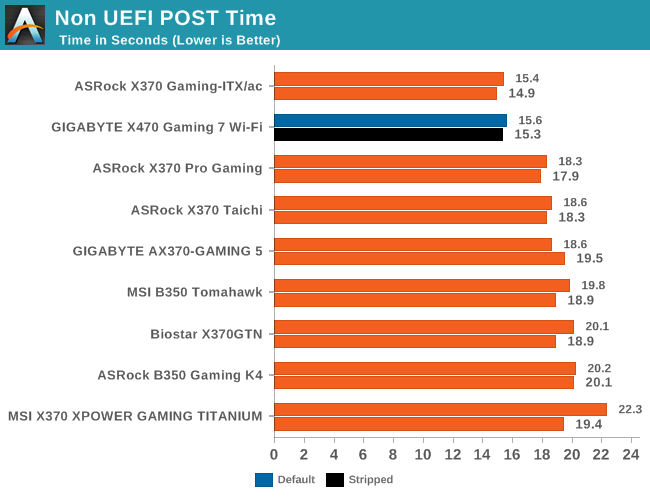
Alongside the ASRock X370 Gaming-ITX/ac small form factor motherboard, the GIGABYTE X470 Gaming 7 Wi-Fi makes a good impression on boot times compared to other AM4 motherboards previously tested. There wasn't much difference between stock settings and with all the malleable controllers disabled, somewhat marginal at best.
Rightmark Audio Analyzer 6.2.5
Rightmark:AA indicates how well the sound system is built and isolated from electrical interference (either internally or externally). For this test we connect the Line Out to the Line In using a short six inch 3.5mm to 3.5mm high-quality jack, turn the OS speaker volume to 100%, and run the Rightmark default test suite at 192 kHz, 24-bit. The OS is tuned to 192 kHz/24-bit input and output, and the Line-In volume is adjusted until we have the best RMAA value in the mini-pretest. We look specifically at the Dynamic Range of the audio codec used on the rear panel of the board.
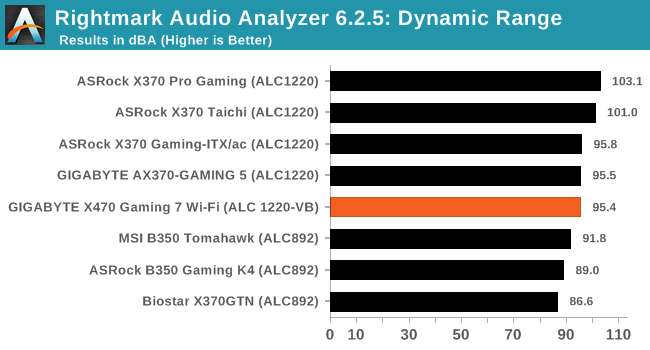
As the results show in RMAA 6.2.5's Dynamic range testing, the newly launched GIGABYTE X470 Gaming 7 Wi-Fi sits at the bottom of Realtek ALC1220 pile, despite being the later ALC1220-VB codec.
DPC Latency
Deferred Procedure Call latency is a way in which Windows handles interrupt servicing. In order to wait for a processor to acknowledge the request, the system will queue all interrupt requests by priority. Critical interrupts will be handled as soon as possible, whereas lesser priority requests such as audio will be further down the line. If the audio device requires data, it will have to wait until the request is processed before the buffer is filled.
If the device drivers of higher priority components in a system are poorly implemented, this can cause delays in request scheduling and process time. This can lead to an empty audio buffer and characteristic audible pauses, pops and clicks. The DPC latency checker measures how much time is taken processing DPCs from driver invocation. The lower the value will result in better audio transfer at smaller buffer sizes. Results are measured in microseconds.
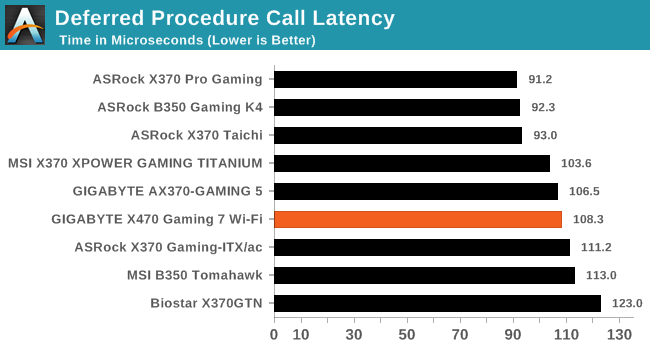
None of the manufacturers AM4 offerings tested so far including the X470 Gaming 7 Wi-Fi are optimized for DPC latency, but the Gaming 7 Wi-Fi does put in a very respectable showing.










29 Comments
View All Comments
DigitalFreak - Thursday, July 26, 2018 - link
The M.2 slot furthest from the CPU is PCI-E 2.0 x4, not PCI-E 3.0.gavbon - Thursday, July 26, 2018 - link
Good spot, edited and thank you :)DigitalFreak - Thursday, July 26, 2018 - link
One other thing - the 3rd (x4) PCI-E slot is PCI-E 2.0, not 3.0.Hxx - Thursday, July 26, 2018 - link
Gigabyte's BIOS is like the quest to create as many submenus as possible and to bury things as deep as they can be buried within those menus. Luckily my Aorus z370 gaming 7 gets the job doneSpoelie - Thursday, July 26, 2018 - link
Another ATX board :/Wanted to upgrade to Ryzen 2 on an ITX board with a 4xx chipset for "proper" precision boost support - but am still waiting on availability of the damn things.
It's come to a point where I'm contemplating skipping this generation as well and wait for 7nm/Ryzen 3 in H1 next year - a "new" desktop nowadays is 5+ year investment anyway
tarqsharq - Thursday, July 26, 2018 - link
I've had my Asus X470 ITX board since the end of May or so?But yeah, waiting for the 7nm shrink might be a really good idea.
29a - Thursday, July 26, 2018 - link
I'm in the same boat as you Spoelie, I'm wanting to upgrade but I want a board with proper precision boast on a lower end chipset in a uATX or ITX form factor but AMD has been so slow about coming out with the new chipsets that now I'm to the point that I should probably wait for Zen2 and the new GPUs.DanNeely - Thursday, July 26, 2018 - link
I'm not sure which is stupider, the frag harder lights on 2 of the PCIe x16 slots, or that they cheaped out and left the 3rd normal.29a - Thursday, July 26, 2018 - link
Just don't turn them on and what seems to be a major source of stress in your life will go away.29a - Thursday, July 26, 2018 - link
Is it me or is this article hard to read? Here are some examples of strange sentences."While not a budget board in any sense of the phrase ($240), the selection of controllers highly the potential upturn in cost for the X470 Gaming 7. "
"While the X370 predecessor to this board (GIGABYTE AX370 Gaming K7) did feature a single U.2 port, GIGABYTE has omitted to implement one onto the X470 Gaming 7. Instead, two M.2 slots are present with both offering support for NVMe PCIe x4 and SATA SSDs with both slots featuring their own individual stylish and functional M.2 heat sinks."